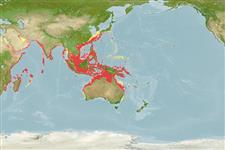>
Eupercaria/misc (Various families in series Eupercaria) >
Lutjanidae (Snappers) > Lutjaninae
Etymology: Lutjanus: Malay, ikan lutjan, name of a fish.
More on author: Cuvier.
Environment: milieu / climate zone / depth range / distribution range
экология
морской; солоноватоводный ассоциированный с рифами; пределы глубины 5 - 180 m (Ref. 6390). Tropical; 34°N - 35°S, 30°E - 171°E (Ref. 55)
Indo-West Pacific: southern Red Sea and East Africa to New Caledonia, north to southern Japan, south to Australia.
Length at first maturity / Size / Вес / Возраст
Maturity: Lm 54.2, range 49 - ? cm
Max length : 116 cm FL самец/пол неопределен; (Ref. 5738); common length : 60.0 cm TL самец/пол неопределен; (Ref. 55); наибольший вес (опубликованные данные): 32.7 kg (Ref. 5738); наибольший возраст (опубликованны данные): 40 годы (Ref. 96972)
колючие лучи спинного плавника (общее число): 11; членистые (мягкие) лучи спинного плавника (общее число): 15-16; колючие лучи анального плавника 3; членистые (мягкие) лучи анального плавника: 10. Dorsal profile of head steeply sloped. Preorbital bone broad. Preopercular notch and knob moderately developed. Scale rows on back rising obliquely above lateral line. Generally red or pink, darker on the back; fins are red except the pectorals which is pink. Juveniles and small adults have a dark red band from first dorsal spine through eye to tip of snout; a 2nd band from mid-dorsal fin to pelvic fin; a 3rd from base of last dorsal spine to caudal peduncle. Large adults become uniformly red (Ref. 9710). Note: (TL, cm) = 1.00 + 1.24 (SL, cm); n = 828 (Ref. 1450). Body depth 2.6-3.0 in SL (Ref. 90102).
Adults occur in the vicinity of coral or rocky reefs (Ref. 5484), often over adjacent sand flats and gravel patches (Ref. 55). Also trawled in deeper water on relatively flat bottoms. Juveniles are frequently commensal with sea urchins (Ref. 55). Juveniles less than 20 cm long are common in near shore, turbid waters (Ref. 27260), in mangrove areas (Ref. 55), or among both coastal and deeper water offshore reefs (Ref. 27260). Juveniles can also be found swimming amongst the spines of urchins in shallow coastal bays (Ref. 48635). They move to deeper waters as they grow larger (Ref. 27264), with large fish often moving into shallower water during the winter months (Ref. 27260, 27264). They form schools of similar-sized individuals or are solitary (Ref. 6390). Feed on fishes, crabs, stomatopods, other benthic crustaceans and cephalopods. Marketed fresh, dried-salted and frozen (Ref. 9987). Commercially important but in certain regions of the Indian Ocean, large individuals are known to cause ciguatera poisoning (Ref. 11888).
Emperor red snappers are broadcast spawners (Ref. 28009).
Allen, G.R., 1985. FAO Species Catalogue. Vol. 6. Snappers of the world. An annotated and illustrated catalogue of lutjanid species known to date. FAO Fish. Synop. 125(6):208 p. Rome: FAO. (Ref. 55)
Статус Красного Списка МСОП (Ref. 130435)
Угроза для людей
Reports of ciguatera poisoning (Ref. 11888)
Использование человеком
рыболовство: коммерческий; аквакультура (рыбоводство): коммерческий; объект спортивного рыболовства: да; аквариум: коммерческий
дополнительная информация
инструменты
Специальные отчеты
Скачать в формате XML
ресурсы в Интернет
Estimates based on models
Preferred temperature (Ref.
123201): 22.9 - 28.5, mean 27.1 °C (based on 1153 cells).
Phylogenetic diversity index (Ref.
82804): PD
50 = 0.5000 [Uniqueness, from 0.5 = low to 2.0 = high].
Bayesian length-weight: a=0.01413 (0.01053 - 0.01895), b=3.03 (2.94 - 3.12), in cm total length, based on LWR estimates for this species (Ref.
93245).
Trophic level (Ref.
69278): 4.1 ±0.4 se; based on diet studies.
Generation time: 6.9 (5.0 - 7.8) years. Estimated as median ln(3)/K based on 12
growth studies.
устойчивость к внешним воздействиям (Ref.
120179): средний (среднего размера), минимальное время удвоения популяции 1.4-4.4 года (K=0.13-0.38; tmax=35; Fec=5 million).
Fishing Vulnerability (Ref.
59153): High vulnerability (59 of 100).
Nutrients (Ref.
124155): Calcium = 16.5 [7.9, 30.5] mg/100g; Iron = 0.269 [0.151, 0.543] mg/100g; Protein = 18.3 [16.6, 19.8] %; Omega3 = 0.104 [0.059, 0.177] g/100g; Selenium = 89.2 [42.1, 187.5] μg/100g; VitaminA = 91 [13, 495] μg/100g; Zinc = 0.321 [0.212, 0.502] mg/100g (wet weight);
